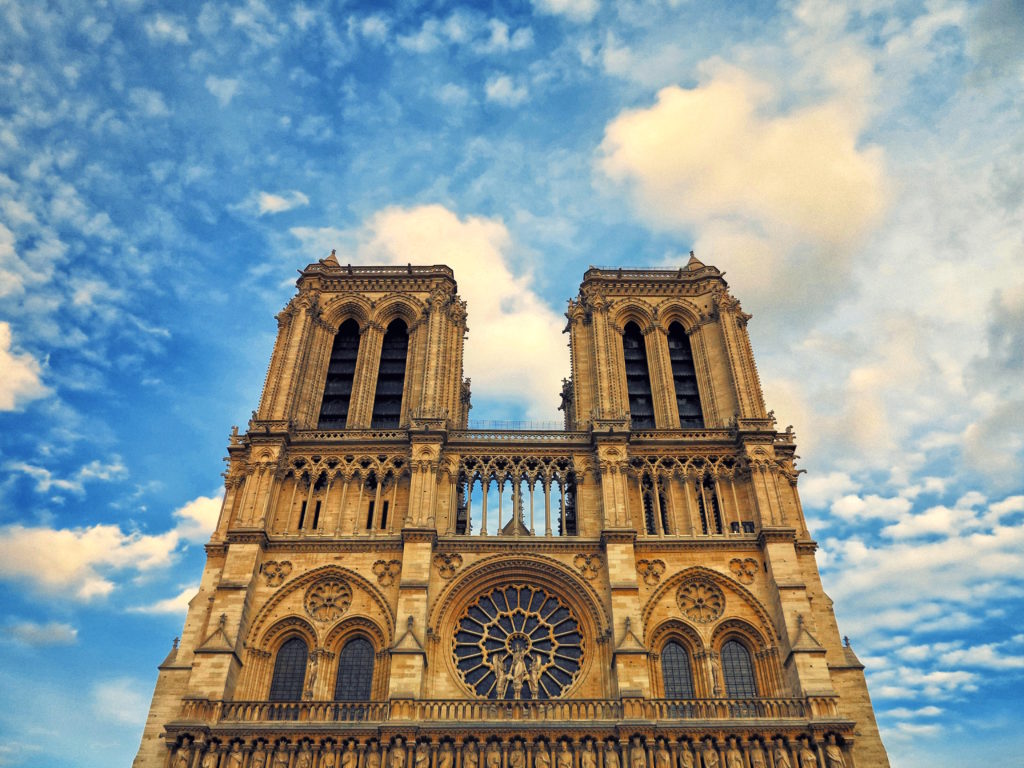A crowd presses up against the stone parapet along the Quai de Montebello and the Pont de l’Archevêche, gazing across the Seine to the Isle de la Cité and the looming presence of the cathedral of Notre-Dame de Paris. The mood is somber, like a funeral. On April 15, the cathedral was disfigured by a devastating fire that destroyed its roof, attic, and splendid 180-foot tall spire. In the weeks that have followed, a crowd has kept a reverent vigil. Their faces reveal shock and sadness, as if each of them were standing in front of his own house after it had burned down. Yet there is another feeling as well: gratitude that the bulk of the monument was spared from the even more terrible loss that the pictures on the night of the fire seemed to suggest. The cathedral, though seriously damaged, is still there.
The major loss was the timber roof structure, largely original medieval construction. This timber structure was so dense with stout oak beams and rafters that it was called “the forest,” and it burned like one. The structure, externally sheathed in lead sheets, provided the protective covering for the masonry vaulting below, which would be vulnerable if left unprotected from the weather. The fire also caused the collapse of the cathedral’s spire or flêche (literally the “arrow” of the cathedral).
The iconic spire was designed by Eugène-Emanuelle Viollet-le-Duc (1814–1879) as part of a twenty-five-year-long restoration project begun in 1844, which sought to repair the extensive damage caused by vandalism during the French Revolution and the decades of neglect that followed. Viollet-le-Duc’s design for the flêche was not a “pastiche” or a Romantic recreation of the past. Rather, it was an act of artistic empathy based on thorough knowledge. It was an “invention within a style,” proving that the Gothic was not a dead language that was limited to a single historical period, but a living tradition that could be summoned to new life in the present. It was this sense of continuity, both in style and in method, that caused his approach to be rejected by the Modern Movement in architecture, for whom dramatizing the difference between the historic and the new was more important than returning the monument and its setting to a state of wholeness.
This attitude still prevails today. Indeed, dozens of designs have been submitted by architects from around the world who propose replacing the destroyed roof and spire with structures of steel and glass. Leaning heavily on a superficial grasp of the rhetoric of environmental sustainability, renderings showed monumental installations involving photovoltaic panels, a new “forest” of living trees, and abundant water, as if what the cathedral needs is a greenhouse-cum-rain forest that produces its own electricity. Aside from their radical visual contrast, these proposals betrayed their authors’ ignorance of the practical requirements of creating a public space—with all the attendant vertical circulation and services—hundreds of feet in the air. Their technical incompetence aside, these proposals cast into high relief the broader cultural issues affecting the discourse in architecture and heritage conservation today.
Start your day with Public Discourse
Sign up and get our daily essays sent straight to your inbox.The “Architecture of Our Time”
Contemporary architecture is the product of a century-old process that sought an uncompromising rupture between the art of the past and that of the present. The Hegelian-Marxian worldview that dominated the early twentieth century saw successive styles in art and architecture as unique and inimitable expressions of their temporal periods, defined as slots on a timeline. The timeline as a whole was directed by the zeitgeist that impelled the styles toward their inevitable culmination in Modernism.
For an architect to design a building that resembled something from an earlier period would be to deny this autonomous historical process. Only the “architecture of our own time”—as defined by the leading form-givers of our own historical moment—is authentic. This architecture, by definition, must resemble nothing that has gone before.
In 1931, the French-Swiss architect Le Corbusier, the Swiss architectural historian Siegfried Giedion, and a group of followers founded the Congrès Internationale d’Architecture Moderne (CIAM) and drafted a manifesto known as the Athens Charter. This Charter (not to be confused with a separate, unrelated charter on conservation of the same year also known as the Athens Charter) articulated the modernist position: “The practice of using styles of the past on aesthetic pretexts for new structures erected in historic areas . . . will not be tolerated in any form.” Any imitation of historic styles is “to institute the ‘false’ as a principle, since the working conditions of former times cannot be recreated and since the application of modern techniques to an outdated ideal can never lead to anything but a simulacrum devoid of all vitality.” Imitation dishonors the imperatives of the present and “results in artificial reconstruction capable only of discrediting the authentic testimonies that we were most moved to preserve.”
From the CIAM viewpoint, Gothic cathedrals have no place in the future. They are only permitted to survive as historical monuments because they are “an expression of a former culture.” Although it is now nearly ninety years old, the CIAM Athens Charter is far from being a historical artifact. Indeed, it forms the unacknowledged subtext of those glass roofs and twisting spires proposed for the “reimagined” Notre-Dame.
The Impact of the Modern Movement on Architectural Conservation
The field of architectural conservation has not escaped the influence of the Modern Movement. Not only would new buildings in previous styles be discouraged, but anything added in the process of restoration must be “distinct from the architectural composition and bear a contemporary stamp,” as stated in Article 9 of the 1964 Venice Charter of the International Council on Monuments and Sites (ICOMOS), an affiliate of UNESCO. Many have interpreted this article as requiring conspicuously modernist new work in historic settings, although this is a distortion of the original intended meaning of the text and may violate other articles in the same document. Still, this reading has given license to innumerable interventions that repeat the cliché of the glass-box addition to the Georgian brick house museum.
Similarly, in the United States, the Secretary of the Interior’s Standards for Rehabilitation issued by the National Park Service in 1977 (last revised in 1995) require that new construction related to historic structures be both “differentiated” from and “compatible” with the original fabric. The possibly oxymoronic pairing of these two adjectives continues to create confusion, which is frequently overcome by insisting on the first and ignoring the second. Like the Venice Charter, the Standards do not require modernist additions to historic buildings—indeed, one could read “compatible” as prohibiting them—or forbid reconstruction of documented historic structures after a disaster, but promoters of the modernist aesthetic have cleverly taken advantage of the linguistic ambiguities to persuade many in the field that they do.
This interpretation is not the consensus view in international conservation circles, however, and over two dozen subsequent documents issued by various bodies after the Venice Charter add needed nuance. As the 2011 Valletta Principles of ICOMOS state, “Regardless of style and expression, all new architecture should avoid the negative effects of drastic or excessive contrasts and of fragmentation and interruptions in the continuity of the urban fabric and space.”
Another doctrine widely accepted in conservation is that the contributions of all periods to the monument constitute a palimpsest of historical moments and must be respected. “Respect” does not mean that nothing may change, but any changes should be coherent with the cultural significance of the monument. We are not free to add and subtract based solely on contemporary taste. Instead, we must make every effort to understand the monument and its complex history on its own terms before deciding how best to protect it and reveal its significance. Disregard for the contribution of Viollet-le-Duc at Notre-Dame would violate this important principle.
The mainstream view in the conservation community was expressed by former director of the UNESCO World Heritage Center, Francesco Bandarin, who noted the “outstanding universal value” of the cathedral, including its nineteenth-century restorations, and called for the monument to be restored precisely to its pre-fire appearance. Over a thousand conservation experts weighed in with a similar public declaration. Other thoughtful responses were offered by Mark Allan Hewitt in Common Edge and Peter Pennoyer in The New Criterion.
Skepticism that restoration is possible was another of the arguments made by the architects in favor of their “innovative” schemes. Many claim that the materials, know-how, and craftsmanship needed for a thorough restoration are no longer available. However, possibly the only silver lining in this tragedy is that it happened in France, a country with some of the most capable conservation specialists in the world. While critics have rightly criticized the national and local governments’ deferred maintenance of Notre-Dame and other monuments throughout France (it was this that finally prompted the major maintenance and preservation work that was in progress when the fire broke out), the French program of training and cultivation of traditional building skills is second to none. For example, the Campognonage du Devoir, the contemporary successor to the medieval craft guilds that originally built Notre-Dame and other monuments, continues its patient work of training young people in traditional building skills. This was the inspiration for the only design proposal seen so far that calls for both complete restoration of the cathedral and a systematic training program at the site to promote the traditional crafts and skills that can ensure the monument’s survival into the future.
Restoration and Authenticity
Still, even if restoring Notre-Dame is possible and financially feasible, to reproduce a historical design in new materials is inauthentic, the architects say. The new Notre-Dame should express “our time.”
This brings us back to the zeitgeist and the timeline. In conservation discourse, however, authenticity has a more precise and a more profound meaning. The 1993 Nara Declaration of ICOMOS recognizes that a monument presents us with numerous information sources about the heritage significance of a site—the physical material, the original design intent, and the history of use being among the most important. Authenticity is a measure of the degree to which those information sources are trustworthy. In short, a heritage site is authentic if it tells the truth about how it became what it is.
The reconstruction of a previous state of a structure is not inauthentic just because its material is new or the style is identified with an earlier period. The act of reconstruction itself may be part of the heritage value of the site. This applies whether the reconstruction is comprehensive and occurs all at once—as in the case of a structure rebuilt after war or disaster—or as part of an incremental and continuous maintenance regime that gradually replaces damaged with new material. Such gradual replacement has been practiced at most of the medieval cathedrals, as conservation specialists regularly replaced weathered stones with new pieces precisely reproducing their predecessors. In such cases, what guarantees the authenticity of the site is the “building culture” that allows the ongoing care for the monument, not the age of the particular stones that happen to be present at a given time.
This view of authenticity is important because it emphasizes that historic buildings and sites (especially those still in use) are not dead artifacts but living organisms. A landmark like Notre-Dame is not simply an illustration in an architectural history textbook, as if the building’s value to us were limited to documenting a style that was popular between 1190 and 1425. Rather, it is evidence of a way of conceiving and making buildings embedded in a culture and a religious faith that, while it may not be accessible to us in the same way today, retains a hold on our imaginations and affections. This, after all, is the fundamental reason for the preservation of heritage sites: place-attachment, the recognition that physical places contribute to our sense of orientation and belonging in the world, the opposite of the placelessness that afflicts most of us today. Surely this is also what the crowd on the Quai de Montebello was feeling as they gazed on the wounded cathedral.
The true challenge for the future of Notre-Dame is not technical, but cultural and political. The French president, in announcing the design competition that attracted those glass roofs, called for a new Notre-Dame to be built within five years “even more beautiful than before.” On the other hand, the French Senate, overturning the provisions of a law passed by the National Assembly, stipulated that Notre-Dame should be faithfully restored.
We can only wait to see how the political decision-making and the technical conservation issues play out in the months and years ahead. In the meantime, the debate about rebuilding the cathedral has already served a useful purpose by putting the philosophical and cultural assumptions underlying the various positions into high relief.












